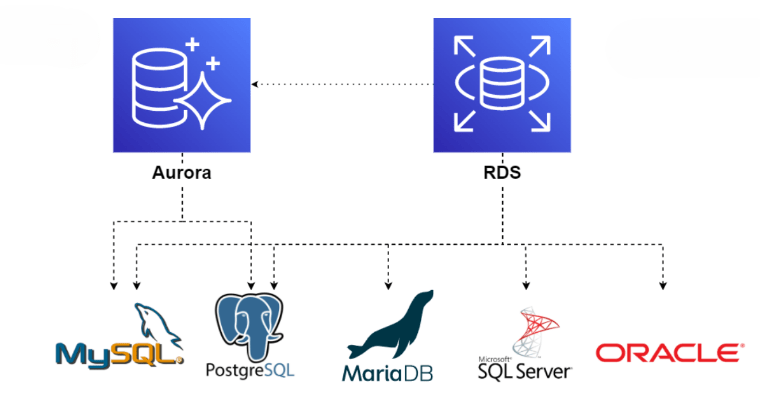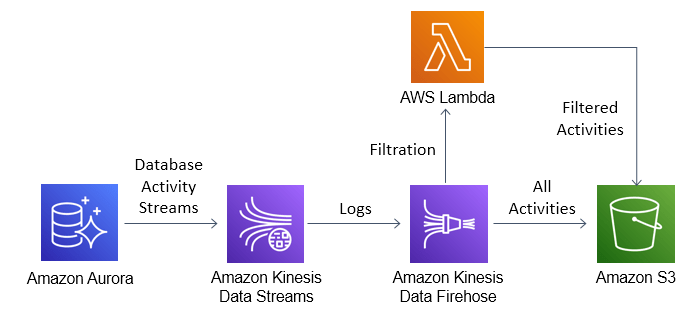
- Introduction to Amazon Aurora
- Key Features of Amazon Aurora
- How Amazon Aurora Works
- Benefits of Amazon Aurora
- Use Cases of Amazon Aurora
- Amazon Aurora vs. Other Databases
- Pricing of Amazon Aurora
- Setting Up Amazon Aurora
- Conclusion
Introduction to Amazon Aurora
Amazon Aurora is a fully managed relational database engine offered by Amazon Web Services (AWS), built to deliver exceptional performance, availability, and scalability. Compatible with MySQL and PostgreSQL, Aurora retains the ease of use and flexibility of these open-source databases while significantly improving speed and reliability. It is capable of delivering up to five times the performance of standard MySQL and up to twice the performance of standard PostgreSQL, making it ideal for demanding applications. Aurora’s architecture is cloud-native, designed to automatically handle critical tasks such as backups, software patching, failure detection, and recovery allowing developers to focus on building applications rather than managing infrastructure. It supports automatic scaling of storage up to 128 terabytes per database instance and offers replication and multi-AZ deployments for high availability and fault tolerance, which are key topics covered in Amazon Web Services Training. Aurora integrates seamlessly with other AWS services such as Lambda, CloudWatch, Identity and Access Management (IAM), and more, making it a core component for modern cloud solutions. Whether used by startups or large enterprises, Amazon Aurora delivers a cost-effective, secure, and reliable solution for running mission-critical workloads in the cloud with minimal operational overhead.
Interested in Obtaining Your AWS Certificate? View The AWS Course Offered By ACTE Right Now!
Key Features of Amazon Aurora
Amazon Aurora provides many features that offer high availability, low latency, and seamless scalability. Some of its most prominent features include:
- MySQL and PostgreSQL Compatibility: Aurora is fully compatible with MySQL and PostgreSQL, meaning that applications using these databases can easily migrate to Aurora with minimal changes.
- High Availability: Aurora offers a multi-AZ (Availability Zone) deployment, replicating data across three separate availability zones to ensure high availability. This minimizes the risk of database failure.
- Automated Backups: Aurora automatically backs up your database to Amazon S3 and supports point-in-time recovery. As outlined in Getting Started with AWS OpsWorks, you can restore backups up to 35 days in the past.
- Read and Write Scalability: Aurora allows you to independently scale read and write operations. Adding up to 15 low-latency read replicas will enable you to distribute read-heavy workloads across multiple nodes.
- Performance and Speed: Aurora is optimized for performance, offering up to 5x the throughput of standard MySQL databases and up to 2x the throughput of standard PostgreSQL databases.
- Automatic Failover: In the event of a failure, Aurora automatically switches to a standby instance without requiring manual intervention, ensuring minimal downtime.
- Storage and Compute Separation: Aurora separates the storage and compute layers, allowing the database’s compute nodes to scale independently of the underlying storage. This results in cost efficiency and the ability to handle large-scale workloads.
- Distributed and Redundant Storage: Aurora automatically replicates data across six copies in three availability zones, ensuring durability and high availability. This replication is handled automatically, with no user intervention required.
- Automated Backups: Aurora is fully managed and continuously backs up your data and stores it in Amazon S3. As highlighted in Essential Aspects of AWS IAM, this ensures secure and reliable data storage. It also supports point-in-time recovery so that you can restore your database at any second within the backup retention period (up to 35 days).
- Query Processing: Aurora uses a distributed query processing system to efficiently handle large-scale read and write operations. By optimizing query processing across multiple storage layers, Aurora can handle high-throughput workloads with low latency.
- Scaling and Replication: Aurora allows for automatic scaling of storage up to 128 TB per database volume. It also allows users to add read replicas to improve the database’s read capacity, enabling it to handle large numbers of concurrent queries.
- Web Applications: Aurora is often used to power modern web applications, as it can scale automatically based on the application’s needs and provide high availability and performance.
- E-Commerce: E-commerce platforms can benefit from Aurora’s ability to handle high throughput and large-scale data operations, ensuring a seamless user experience even during traffic spikes.
- SaaS Applications: SaaS applications that require scalable, low-latency databases can rely on Aurora for improved performance and easy management, a concept often emphasized in AWS Training.
- Mobile Applications: Aurora’s speed and scalability make it ideal for supporting mobile applications that need a reliable database backend to store user data and process transactions.
- Gaming Applications: Gaming platforms with heavy transactional loads can benefit from Aurora’s ability to handle high traffic and provide low-latency responses for users worldwide.
- Data Warehousing: Aurora can be used for data warehousing needs, providing fast analytics and reporting on large datasets. The ability to integrate with other AWS services like Redshift and S3 makes it a powerful tool for data management.
- Instance Costs: Aurora charges for the compute resources based on the instance size and the number of instances in use. You can choose from a variety of instance types to match your needs.
- Storage Costs: Aurora charges based on the amount of storage you use, as is common with many Cloud Computing Platforms and Services. The storage automatically scales with the size of your database, and you pay for the actual storage consumed.
- I/O Requests: Aurora charges for the number of read and write I/O operations performed on the database. However, the pricing for I/O operations is relatively low compared to other database services.
- Backup Costs: While Aurora automatically takes backups, there are additional charges for backup storage if the free backup allowance is exceeded.
- Data Transfer: Aurora charges for data transfer, particularly when data is transferred from the AWS region.

How Amazon Aurora Works
Amazon Aurora works by utilizing a distributed, fault-tolerant storage system. Unlike traditional relational databases, which store data on single machines, Aurora’s storage is spread across multiple availability zones within an AWS region. Here’s how it works:
Are You Interested in Learning More About AWS? Sign Up For Our AWS Course Today!
Benefits of Amazon Aurora
Amazon Aurora provides a comprehensive set of benefits that make it a compelling choice for a wide range of applications. One of its standout features is high performance Aurora delivers up to five times the throughput of standard MySQL databases and twice that of standard PostgreSQL by leveraging a distributed, high-performance storage system that enables faster read and write operations. It also offers seamless scalability, with automatic storage scaling that allows databases to grow as needed without manual intervention, along with the ability to scale compute resources to match varying workloads, similar to the capabilities discussed in Azure Front Door Web Traffic Management. Aurora is fault-tolerant and highly available by design, replicating data across multiple Availability Zones and providing automatic failover in case of issues, ensuring minimal downtime. Its cost-effective pricing model is based on actual usage, eliminating upfront costs and allowing users to pay only for what they use. As a fully managed service, Aurora automates routine administrative tasks such as backups, patching, and monitoring, significantly reducing operational overhead. Security is also a priority, with features like encryption at rest and in transit, VPC network isolation, IAM-based access controls, and compliance with industry standards making Aurora a secure and reliable choice for critical applications.
Use Cases of Amazon Aurora
Amazon Aurora is suitable for a wide variety of use cases, particularly those that require high availability, scalability, and firm performance. Some everyday use cases include:

Looking to Master AWS? Discover the AWS Masters Course Available at ACTE Now!
Amazon Aurora vs. Other Databases
When comparing Amazon Aurora to traditional database solutions like MySQL, PostgreSQL, or even Amazon RDS, several key differences stand out. Aurora is specifically optimized for high performance, delivering up to five times the throughput of standard MySQL and twice that of PostgreSQL, thanks to its distributed architecture that allows for faster data processing. Unlike the traditional single-node structures of MySQL and PostgreSQL, Aurora is built to scale horizontally, enabling it to efficiently manage much larger datasets without compromising performance. In terms of high availability, Aurora offers built-in fault tolerance with automatic data replication across three Availability Zones and seamless failover, features that require more complex configurations in standard MySQL or PostgreSQL deployments, unlike the container orchestration approaches seen with Ansible, Kubernetes, and Docker. Another major advantage is that Aurora is fully managed by Amazon Web Services, meaning tasks like backups, patching, monitoring, and scaling are handled automatically significantly reducing administrative overhead. While MySQL and PostgreSQL databases hosted on AWS require more manual intervention, Aurora provides a streamlined experience. Additionally, Aurora’s pay-as-you-go pricing model ensures cost-effectiveness by charging only for resources used, making it a more flexible and economical option for growing, cloud-native applications.
Pricing of Amazon Aurora
Amazon Aurora’s pricing is based on several factors, including the instance size, storage, and data transfer. Key components of Aurora pricing include:
Preparing for a AWS Job Interview? Check Out Our Blog on AWS Interview Questions & Answer
Setting Up Amazon Aurora
Setting up Amazon Aurora is a simple and streamlined process, thanks to its fully managed design. To begin, you can create an Aurora database cluster through the AWS Management Console, selecting either MySQL or PostgreSQL compatibility based on your application requirements. During the setup, you’ll configure your instance by choosing the instance type, determining the number of instances needed, and specifying storage preferences. Aurora allows you to fine-tune performance and availability according to your workload. Next, it’s important to set up your backup and security configurations. Aurora supports automated backups, enabling point-in-time recovery, and offers encryption at rest and in transit to ensure your data remains secure, aligning with best practices from Kubernetes & DevOps for Streamlined Operations. You can also configure access controls using Amazon Web Services Identity and Access Management (IAM) and Virtual Private Cloud (VPC) settings. If you’re migrating from an existing database, services like AWS Database Migration Service (DMS) or third-party tools can be used to move your data into Aurora with minimal downtime. Once your database is running, you can monitor performance and health metrics using AWS CloudWatch and scale your resources up or down easily, ensuring your database grows with your application’s needs.
Conclusion
Amazon Aurora is a fully managed relational database service designed for high performance, availability, and scalability. Compatible with both MySQL and PostgreSQL, Aurora combines the speed and reliability of high-end commercial databases with the simplicity and cost-effectiveness of open-source systems. It delivers up to five times the throughput of standard MySQL and up to three times that of standard PostgreSQL, making it an ideal choice for demanding applications. Aurora automatically handles time-consuming tasks such as provisioning, patching, backup, recovery, and failover, significantly reducing operational overhead a key topic covered in AWS Training. Its architecture is designed to offer continuous backup to Amazon S3, replication across multiple Availability Zones, and quick failover, ensuring data durability and high availability. Aurora also supports seamless scaling of storage up to 128 terabytes per database instance and read replicas to manage growing workloads. Deep integration with the AWS ecosystem means it works effortlessly with services like Lambda, CloudWatch, and Identity and Access Management (IAM). Whether you’re building modern web apps, e-commerce platforms, or enterprise-grade applications, Aurora provides the performance, reliability, and security needed for mission-critical workloads, making it a leading choice for cloud-native development.





